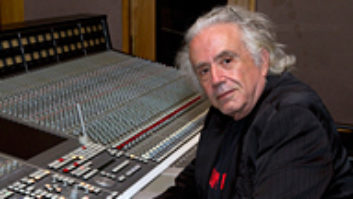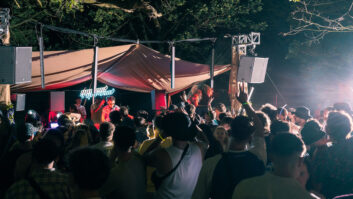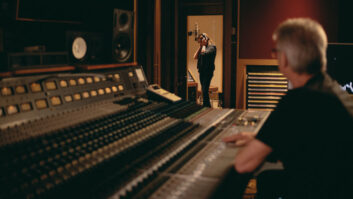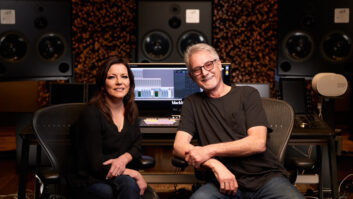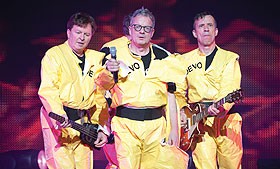
After rescheduling some shows, DEVO is back on the road in support of their new album, Something for Everybody, the band’s first studio release in 20 years. Songs such as “Fresh” and “Please Baby Please” have all the hooks, rhythms and beats of past classic DEVO hits. The band’s performance at San Francisco’s Warfield Theater was energetic and tight, covering the band’s hits and favorites.

Front-of-house engineer Van Coppock is relying on house-provided gear.
Front-of-house engineer Van Coppock is relying on house-provided gear. His first choice in a board is a Yamaha PM5D, “mainly because we have an opening act traveling with us and many places can’t accommodate both bands,” Coppock says. He has files for most digital boards, but finds that the 5D is usually the easiest to get and is simple to use. “I would still prefer a big fat analog desk any day of the week,” he adds. “The Midas H3000 is my first choice.”
Coppock uses whatever processing is onboard. If mixing on an Avid VENUE, he’ll activate the desk’s Bomb Factory, 1176 and LA-2A for compression, and delays and reverbs. If working on an analog board, he’ll use Drawmer 201 gates on drums, dbx 160X comps for bass/vocals, a compressor across the keys, Yamaha SPX-90s or SPX-990s, TC Electronic D2 delay and Roland SDE 3000 delay.
P.A. is also du jour, with Coppock preferring an L-Acoustics V-DOSC or a Meyer Sound system. “Regardless of the size of the venue, I treat the P.A. like a huge set of studio monitors. I know how DEVO is supposed to sound having worked with them in the studio for many years, and that sound is always my goal.”
Gerry Casale’s (bass, synths, vocals) Steinberger runs through a Line 6 Bass Pod mixed with a DI signal.

Monitor engineer Neil Taylor also prefers a Yamaha PM5D, but has manned an Avid Profile, Soundcraft VI and a Yamaha M7CL.
Monitor engineer Neil Taylor also prefers a Yamaha PM5D, but has manned an Avid Profile, Soundcraft VI and a Yamaha M7CL. “I’m using onboard software. The EQ, dynamics and processing work fine, but with the 5D, an external clock makes an incredible difference to the sound and performance of that desk. An Apogee Big Ben is your best friend if you find yourself on a 5D.”
Taylor runs 12 mixes: five downstage wedges, left and right sidefills, drum fill, mono ear for click and three upstage wedge fills that act as guitar cabinets. Guitars and bass are DI, so Taylor sets up a wedge behind Gerry Casale, Bob Mothersbaugh and Bob Casale facing downstage and fed to their guitars. They each also have downstage wedges, and Gerry Casale has a considerable amount of kick and snare in his fill.
Mark Mothersbaugh (vocals and keys) and Gerry Casale sing through Shure UHFRs with 87A capsules. On “What We Do,” Gerry Casale sings through an RF mic. Hardwired vocals are Shure 58s: One when Gerry Casale plays bass and one on Bob Mothersbaugh and Bob Casale, and a spare coiled downstage by Mark Mothersbaugh’s wedges.
According to bass/drum tech Nick Rowe, Josh Freese’s kit has the following mics: Beta 52, kick; SM57s, top and bottom snare; 81s, hi-hat and overheads; and Sennheiser 604s, toms. “We use a hardwired Shure ear pack for Josh,” Rowe adds. “It is a home-run mix send from the monitor desk, and all that’s in it is the click track from Pro Tools. Everything else he gets in his drum fill.”
Bob Mothersbaugh (guitars, vocals) uses a Fractal Audio axe effects preamp, and can choose which amp model and stomp box combo. It fits in a rack and sits on top of guitar tech Ed Marshall’s workbox. “We rely on stage monitors to hear instruments onstage. We go direct to the split. He has a footswitch to change from rhythm to lead channels onstage. I have an Ibanez Tube Screamer that I switch for him on ‘Mr. DNA’ and other control settings for some songs.”
Bob Casale’s keys/synth gear includes a Korg TR-61 and a Boss SP-404 sampler for noise elements. For guitar, he uses a Line 6 Pod-XT on the floor and has the three guitar sounds programmed; he switches them onstage. Guitar tech Ed Marshall runs an XLR from his guitar wireless to a line transformer, then into the Pod-XT, then mono out of the pod to a DI.
Mark Mothersbaugh’s keyboard rig comprises a Korg microKORG synth, a Moog Voyager and his original Minimoog. Keyboard tech Cris Callans breaks down the signal flow: “The Korg micro outputs a stereo signal to a stereo direct box. The Voyager and Minimoog output is mono into a Whirlwind A/B box. Output of that is routed to a Dunlop Dimebag Crybaby From Hell wah to Boss DS-1 distortion pedal to Boss DD-20 delay. Output of the delay is inputted to a Whirwhind DI.
“A few of the songs from the new album have certain noise elements that need to be present in their performance,” he continues. “We added a Pro Tools track to play these elements.”


